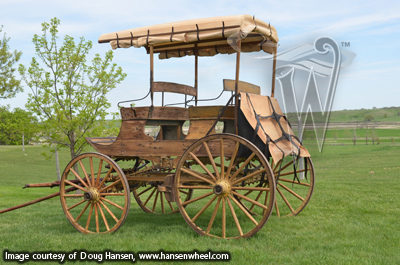At some point, most collectors have been asked the question - "Why do you collect the things you do?" There can be any number of reasons but, ultimately, it's fairly simple; we all tend to gravitate toward the things we like. Beyond that, collectors also typically look for pieces that increase the quality and noteworthiness of their compilation.
When it comes to antique, horse-drawn vehicles, there are at least a handful of characteristics I like to see. In particular, I look for higher quality features that enhance the condition of the piece. Coupled with significant originality levels, desired rarity, provenance, and completeness, each has a way of setting an individual vehicle apart from the crowd. The overall depth of a collection can also reinforce its significance. To that point, recently, we were fortunate to expand the diversity of our collection to include an original California stage wagon.
 |
The conservation work done on this mountain stage wagon was focused on preserving the original look and legacy of the vehicle's history. |
Deaccessioned from a museum, this western stage will date to the late 1800s. The smaller, do-it-all design was geared for shorter runs over the rugged terrain between mining communities. Supported by 1.5-inch steel axles, Sarven hubs, and 1 3/4-inch springs, the configuration carried lighter loads of passengers, mail, packages, and gear. Highlights of the pattern include a triple reach, covered rear boot, footbrake, side curtains, heavy brake beam, and period correct tongue. From top to bottom and everything in between, it was engineered for strength, fleetness, and flexibility.
Over the last several months, the stage has been at Doug Hansen's shop in Letcher, South Dakota for a little TLC to bring it back to operating condition. At the same time the reconditioning was taking place, we wanted to preserve the original, as-used character and hard-earned patina.
In fact, throughout the conservation efforts, we worked closely with Hansen's team to both maintain and protect the historic integrity of the vehicle. As with virtually any century-plus-old set of wheels, some pieces were missing or broken and needed repair. The work process went so far as to use timeworn materials wherever possible. In several places, we were able to employ aged wood and even period leather left over from the restoration of another old California coach. So, today, those parts of yesterday live on in this stage wagon. It's just the kind of serious attention to detail and period-correct conservation that helps perpetuate authentic history for generations to come.
From features to function and purpose to place, stagecoaches came in all sizes, shapes, configurations, and capacities. Some of the most recognized designs are the heavy Concord coaches built by Abbot-Downing or the lighter mud wagons or even touring coach styles built by a number of manufacturers such as M.P. Henderson of Stockton, California. Even so, there were many other types of stages serving both remote towns and popular destinations. All of these wheels have a way of reinforcing the rich history of America while showcasing the true depth of our nation's first transportation industry.
Anytime we can help save and share another part of the Old West we pay tribute to those who came before us while serving as good stewards to those who come after. After all, the process of collecting is always bigger than ourselves. It's about preserving time and sharing a historic way of life. As such, it has a way of bringing people together who may have been worlds apart - just the way the original coaches did so many years ago.
Please Note: As with each of our blog writings, all imagery and text is copyrighted with All Rights Reserved. The material may not be broadcast, published, rewritten, or redistributed without prior written permission from David E. Sneed, Wheels That Won The West® Archives.